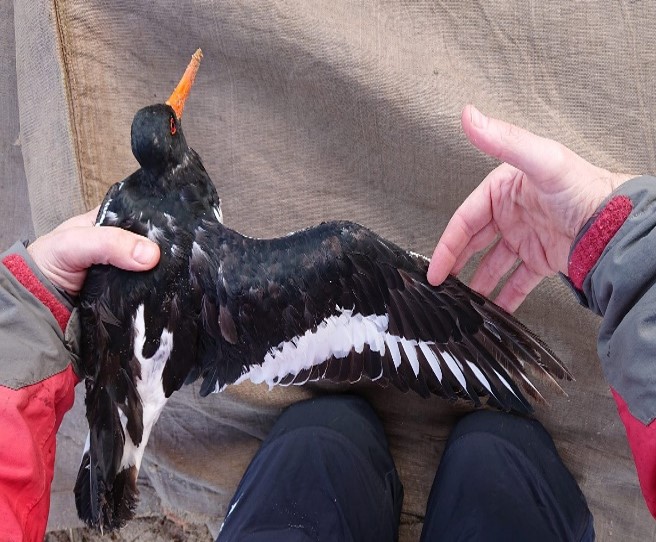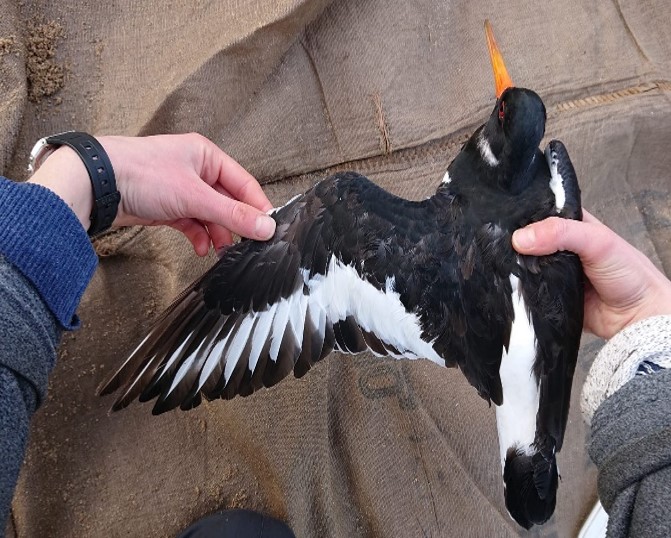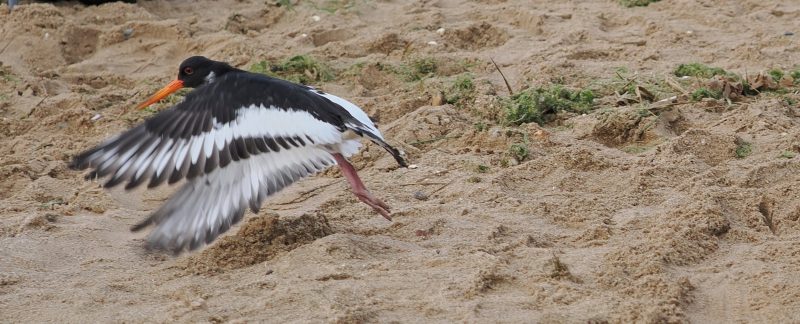Friday 25 November
Recces:
Lucy Y. and Mark went out to recce in the morning. Around 07:00 at the Heacham Dam, Snettisham North, Lucy saw no birds, but by 07:15, groups of 30–200 Sanderling began to gather; Lucy also looked at Heacham South where 1,500–2,000 Oystercatchers were already present at 07:00, and stayed until 10:00, settled even with dog walkers going past the flocks on the beach. There were also a few hundred Oystercatchers roosting on the concrete slope of the Heacham Dam. Mark saw 10 Sanderling and six Turnstone at Heacham North, and 10 Oystercatchers at Heacham North North.
Most of the team gathered at the base on Friday afternoon/evening and enjoyed a jacket potato meal made by Mark. At 20:15 Lucy Y. held a team briefing, discussing timings and plans for the evening’s cannon-net setting and the morning’s catch at Heacham South, just south of the Tump. Earlier, the team leaders had decided it would be best to attempt to catch the Oystercatchers Lucy Y. had seen as we had two good Sanderling catches on the October weekend trip. While Skye was intermittently a wolf, a frog and a dog called Gyp, we went round the group introducing ourselves. Ian and Seb arrived just after the briefing.
The trailer was packed, and we set off for Heacham South, arriving at 21:30. With admirable dedication, Seb stayed behind to revise for his GCSEs. While the team leaders had a look about the beach to find the markers Lucy Y. had earlier put down and decide on positioning (which had to be altered a bit as the tide had made by 50 cm), the rest of us, having hauled all the equipment onto the beach, turned off our head-torches to look at the stars. A beautifully clear night, Jupiter, Mars and many constellations (pointed out by Rob Rob) could be seen, as well as shooting stars. In the end we set two lines (staggered) of two full, small-mesh nets (so four nets in all). One pair was set very close to the predicted tide line, with jumps to increase our reach if the birds were further out, while the other pair was higher up and with no jumps. This set up increased our chance of catching whether the tide made or not. The original hope was to catch around the high tide period, it being light enough to catch about 15 minutes before high tide, or on the falling tide – the set-up of the nets gave us the option for both. The nets were set up efficiently and Mark trained Ian, Lucy C. and Flo on how to pace and angle the cannons. We returned to the base and, before bed, re-packed the trailer with equipment needed for the catch.
Saturday 26 November
While Sam was to join us later with Skye, the rest of the team were up at 04:45, out at 05:30 and reached Heacham South just after 06:00. Radios were dished out, Mark, Guy and Lucy Y. quickly got into the firing position, and longstops Alex and David H. set off to direct any dog-walkers away from the area. Ryan briefed the basecamp team. While longstopping, David came across two largely intact goose carcasses on the strandline, one Pink-footed and one Greylag. It is possible that these are the victims of Highly Pathogenic Avian Influenza (HPAI), which we have all been looking out for given the recent outbreaks, but it is not unusual to see a small number of dead geese on the tideline at this time of year.
Unfortunately, an extremely early dog walker was passing the firing position as we arrived, having already gone past the nets, and there were no birds on the beach. This was discussed over radio as basecamp waited in position behind the dunes, and after a suggestion from Guy, Sam (who had not yet left the base), was phoned, with urgency, to bring decoys. Rob Rob was asked to go over the dunes and check the state of the lower pair of nets as the tide already looked high: they were completely underwater – the tide had made again. Ryan, Lucy Y., Guy and Mark discussed whether to move/reset the remaining nets.
Eventually, as visibility increased and it seemed no birds were going to return and the upper nets might also be covered by the tide (which was uncomfortably close to them with half an hour to go until high tide), a conclusion was reached and we clambered over the dunes to pull up all four nets, lifting the wet pair over the marram grass to begin drying. But, as we were finishing up, Cathy pointed to an ‘oil slick’ of Oystercatchers which had descended on the beach only a few hundred metres away! We all gathered by the trailer back over the dunes and Lucy Y. explained to the team what was happening. This newly arrived flock changed matters slightly and, instead of giving up or even going to a different beach to try for a falling tide catch, it was decided that we should reset one net and have one more go.
Meanwhile, a purple haze of early light drifted over the distant woodland. Thousands of Pink-footed Geese clamoured in graceful skeins high in the clouds, a murmuration of Starlings whooshed low overhead and a Kestrel hovered above the scrub.
We all got back into position, with Mark on the beach north of the nets ready to call the catch; Lucy and Guy could not get into position to call the catch from the south of the nets until after the birds had been twinkled, without risking flushing the birds in the wrong direction. Cathy (and Rob Rob, self-admittedly a spare part) twinkled the flock towards the catching area. Then followed a bit of a rush: the tide was falling fast, leaving only so much time before the birds would be too far down the beach to reach; Sam had by this time arrived, and seven decoys were hurried out onto the shore to encourage the birds to land in the catching area; Ryan tested the net and the dropper wasn’t working, so after a rapid decision, a new dropper was brought out and set in the space of two minutes! Meanwhile at basecamp, we had no one who could connect up the firing box as Ryan ran off the beach. Thankfully Sam stepped up to man the box. Cathy successfully twinkled the Oystercatchers directly into the catching area. It was later concluded that Guy’s call for decoys was very wise. The last basecamp heard over the radio was that there were 20ish birds catchable. On command, Sam pressed the button, and, with the bang, we charged over the dunes, only to see that there were quite a lot more than 20 birds under the net… We ran into the sea and, with a tent lift, shuffled the catch onto dry beach, with Ryan, Chantal, Rob P. and David K. dedicated to the corners. The lift went well, the Oystercatchers did their usual thing and moved towards the sea rather than away from the humans, so about 20 escaped from under the front edge of the net. While extraction began, boxes were fetched, and five birds put in each. With birds being extracted quickly, the keeping cages were swiftly set up – and very near the net – so many birds were simply carried straight into the compartments. Skye assisted in ferrying several birds over from the net.
Once all birds were safely in keeping cages and the nets spread out to dry, Lucy Y. led a team talk and we began the next tasks: Sam and Cathy colour-ringed and flagged the single Bar-tailed Godwit and the two Knot caught, then Sam and David H. led separate processing teams, and Guy led the ringing team. Michèle and Nicholas had arrived (with their dog Dusty) by this point and joined in with the ringing. Time of fire was 08:15 and the last bird was weighed at 11:30. Three Oystercatchers had old injuries: one with only one leg, one missing a foot, and one with a very bent and disfigured leg. Some of the Oystercatchers were in arrested moult, where the bird stops moulting before it has finished, as opposed to active moult where feathers are growing. Lucy Y. noted this and explained that it could – though unlikely due to the low number of birds in arrested moult – be an early indication of poor food supply, meaning the birds had to stop moulting as this is an energetically costly process. When cockle stocks crashed on the Wash 20+ years ago, it showed up in lots of Oystercatchers (who normally complete their primary moult in one go) before it was picked up in the cockle monitoring.

Arrested moult (last three feathers are old). Photos by Lucy Yates.

Active (but probably arresting) moult (antepenultimate feather growing, but it is the only moulting feather suggesting that the bird is not going to moult the two outermost feathers, as we would expect more than one feather to be growing at one time.)
Throughout processing and ringing Ryan ensured the HPAI protocols were followed with kit disinfecting, minimising the mixing of birds and regular hand sanitising.
Several friendly members of the public passed by during the processing and were intrigued to learn about what we were doing.
Time of fire: 08:15. Number of nets fired: 1
| Species | New | Retrap | Total |
| Bar-tailed Godwit | 1 | 0 | 1 |
| Knot | 2 | 0 | 2 |
| Oystercatcher | 113 | 86 | 199 |
| Totals | 116 | 86 | 202 |
Back at base, we laid out the wet keeping cages and nets, dusted down the sandy cannons and removed the cartridges, and then tucked into porridge and a hearty breakfast cooked by Ryan, Cathy and Alex. Lucy Y. led a briefing and we created a long list of tasks to complete in the afternoon and evening. The leaders decided the predicted weather of high winds and rain would not be good for mist-netting this evening. Cathy helpfully explained how to properly write out several things when checking data sheets, including the correct format for writing colour ring codes.
Then the jobs commenced. Several people put away the kit from the morning’s catch, David H. sorted out the droppers, Luke and Michèle had an extra colour-mark recording masterclass from Rob P. and tested mist-netting bird bag drawstrings, Flo washed up then joined Chantal, Michèle and Nicholas to do the enormous amount of data, and Alex and Lucy C. cooked the most delicious Mexican fajitas! Ryan was commanded to rest.
After a pudding of leftover-porridge and fruit crumble, Rob P. gave a briefing on resighting plans for the morning, deciding more ground would be covered (and more birds resighted) if we went off in no more than twos or threes. Ryan, Alex and Lucy C. earned many Steve Brownie Points by volunteering to go to Freiston in Lincolnshire hoping to resight Redshank.
The evening descended to much laughter as we attempted a game of Drawing Consequences.
Sunday 27 November
It was decided at the beginning of the trip that we would not be mist-netting on the Sunday evening due to an insufficient number of experienced people. Michèle, Nicholas and Dusty had to leave in the morning so did not join the resighting. Those heading to Freiston left the base at 06:30 while everyone else left at around 07:30. The locations and results of the morning’s resightings, as reported back in a lunchtime team talk, were as follows:
Ryan, Lucy C. and Alex saw 500+ Lapwing but only three Redshank at Freiston, and no flags. They drove to Frampton where there were 1,000s of Lapwing and a small number of Redshank, but still no colour marks. So they went for breakfast in a café instead.
Cathy and Luke saw a 330-strong Curlew roost on the mudflats at Snettisham Pits at high tide, though these were too far away to see any colour marks. Lots of Knot, Bar-tailed Godwit and Oystercatchers were seen. At Snettisham South on the falling tide there were no flags, but a Bar-tailed Godwit was seen exhibiting a strange wobbling behaviour, which could possibly be AI symptoms.
Guy visited the Snettisham fields at high tide and on the falling went to Snettisham North/Heacham Dam. He saw 126 Curlew with 14 flags in one field, one Curlew in another field but none in the rest. At the Dam there were 25 Curlew with six flags, 150 Bar-tailed Godwit with one flag, and 300 Knot including the two birds we flagged yesterday.
Rob P. checked the nine Heacham fields at high tide plus one satellite field, and Carol and Bernard’s field, which had 130 Curlew but only one flag visible. At Heacham South on the falling tide, he read 12 Curlew flags, one Turnstone flag and seven Bar-tailed Godwit flags.
Lucy Y. and Rob Rob went to fields where Curlew satellite tags had previously been noted. Some fields were empty, but one had 20 birds with two flags.
Sam, David H. and Skye visited a second cluster of satellite fields, looking at eight in total. A particularly fruitful field located on the Snettisham-Fring road held 120 Curlew (and several hundred Lapwing), with 12 flags read.
Ian, Seb and Mark went to the Ingoldisthorpe and Dersingham field cluster and saw eight flags at the former and four at the latter. Once back at the base, Mark and David K. cut the hedge.
Colour marks seen:
| Species | Total Sightings | Individuals | WWRG | Non-WWRG |
| Bar-tailed Godwit | 12 | 10 | 9 | 1 |
| Grey Plover | 1 | 1 | 1 | 0 |
| Curlew | 51 | 46 | 46 | 0 |
| Turnstone | 7 | 6 | 6 | 0 |
| Knot | 2 | 2 | 2 | 0 |
| Sanderling | 1 | 1 | 0 | 1 |
| Totals | 74 | 66 | 64 | 2 |
Resighting notes
The oldest Bar-tailed Godwit seen was flagged in 2012 and has been seen 24 times since. The single Grey Plover is regularly seen on the Wash and winters here. We aim to do sub-annual survival analysis of Curlew, with a target of 100 individuals and a minimum threshold of 50 – we nearly reached this in one day! The two Knot seen were flagged on our catch the previous day. The control Bar-tailed Godwit was from Poland. A total of 54 field locations were checked for Curlew, and of the 860 Curlew seen only 330 (less than 40%) were on the intertidal roost.
During the post-resighting briefing Rob P. said that over 70 colour marks were read during the morning (including all three birds flagged in Saturday’s catch), emphasising how important resighting is for data collection, as it would take a huge amount of effort to collect the equivalent data from catching alone. So, a big thanks to the resighters who put in a sterling effort, collecting some really beneficial data.
David K. suddenly realised it was his birthday and so we all sang to him as one of the flapjacks (given to the team by Flo), bedecked in candles, was presented to him.
Then before heartfelt goodbyes and final departures, we all set to on finishing up jobs about the house and submitting resighting data onto the Shiny App.
Special thanks to Alex Dodds and Lucy Capstick who seemed to be involved in all the cooking over the trip!
Thanks to Florence Turner for writing this report

